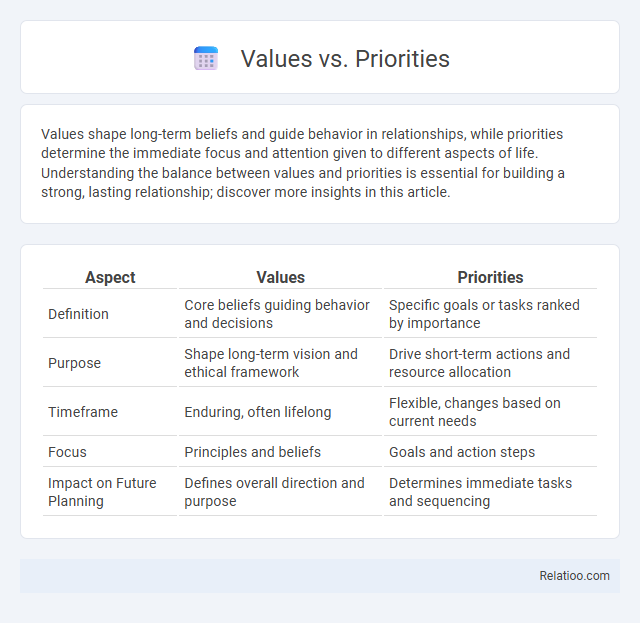Values shape long-term beliefs and guide behavior in relationships, while priorities determine the immediate focus and attention given to different aspects of life. Understanding the balance between values and priorities is essential for building a strong, lasting relationship; discover more insights in this article.
Table of Comparison
| Aspect | Values | Priorities |
|---|---|---|
| Definition | Core beliefs guiding behavior and decisions | Specific goals or tasks ranked by importance |
| Purpose | Shape long-term vision and ethical framework | Drive short-term actions and resource allocation |
| Timeframe | Enduring, often lifelong | Flexible, changes based on current needs |
| Focus | Principles and beliefs | Goals and action steps |
| Impact on Future Planning | Defines overall direction and purpose | Determines immediate tasks and sequencing |
Defining Values and Priorities
Values represent deeply held beliefs that guide behavior and decision-making, reflecting what individuals or organizations consider essential for their identity and ethics. Priorities are specific tasks, goals, or areas of focus ranked in order of importance based on those underlying values. Understanding the distinction between values and priorities enables effective value alignment, ensuring actions and objectives consistently reflect core principles.
The Core Differences Between Values and Priorities
Values represent the fundamental beliefs that guide behavior and decision-making, while priorities are the specific tasks or goals ranked by importance at a given time. The core difference lies in values being enduring and intrinsic, whereas priorities are flexible and context-dependent. Understanding this distinction is crucial for effective value alignment in personal and organizational contexts, ensuring that actions consistently reflect core principles.
Why Values Matter in Life Decisions
Values serve as fundamental guiding principles that influence life decisions by providing a consistent framework for evaluating choices and actions. Priorities reflect the specific application of these values, helping individuals focus on what matters most in different contexts, while value alignment ensures that decisions and behaviors are congruent with one's core beliefs. Recognizing and honoring personal values enhances decision-making clarity, fosters integrity, and improves overall life satisfaction by creating coherence between actions and true self.
How Priorities Shape Daily Actions
Priorities influence your daily actions by determining which tasks receive immediate attention and resources, directly impacting productivity and goal achievement. Understanding the distinction between values and priorities helps you align daily choices with core beliefs, ensuring consistent progress towards meaningful outcomes. Effective value alignment transforms abstract principles into concrete priorities that guide decision-making and behavior throughout each day.
The Interplay Between Values and Priorities
Values represent your core beliefs that guide behavior, while priorities are specific goals or tasks you focus on to achieve desired outcomes. The interplay between values and priorities ensures that your daily actions align with what truly matters, fostering coherence and purpose. When your priorities reflect your values, your decisions become more consistent, leading to greater satisfaction and effectiveness.
Real-World Examples of Values vs Priorities
Values represent enduring beliefs such as honesty or compassion, while priorities are specific actions or goals like career advancement or family time that can shift based on circumstances. For example, a person valuing health may prioritize regular exercise during certain periods but shift focus to work deadlines temporarily, illustrating how priorities fluctuate while core values remain stable. Value alignment occurs when an individual's priorities consistently reflect their deeper values, leading to greater satisfaction and authenticity in decision-making.
Common Conflicts: When Values Clash with Priorities
Conflicts often arise when deeply held values, such as integrity or family, clash with pressing priorities like career advancement or financial stability. These clashes create tension, forcing individuals to choose between what they believe is morally important and what demands immediate action or attention. Resolving these conflicts requires a clear understanding of value alignment, ensuring that short-term priorities support long-term core values to maintain personal and professional harmony.
Aligning Priorities with Personal Values
Aligning priorities with personal values ensures consistent decision-making and authentic goal-setting, fostering long-term fulfillment and integrity. Personal values act as an internal compass, guiding the selection and adjustment of priorities to reflect what truly matters to an individual. Effective value alignment promotes coherence between actions and beliefs, enhancing motivation and reducing internal conflict.
The Impact of Misaligned Values and Priorities
Misaligned values and priorities often lead to conflicts, reduced productivity, and weakened teamwork within organizations. When individual or group values clash with organizational priorities, it creates disengagement and decreases overall morale, impacting business outcomes negatively. Effective value alignment fosters collaboration, enhances decision-making, and drives sustainable success by ensuring all stakeholders pursue common goals.
Strategies for Reassessing Values and Setting Priorities
Reassessing values involves reflective practices such as journaling, seeking feedback, and evaluating life experiences to identify what truly matters at different stages. Setting priorities requires clearly defining short-term and long-term goals aligned with core values, using tools like priority matrices and time-blocking techniques to ensure focused action. Value alignment strategies include regular check-ins, mindful decision-making, and adjusting goals to maintain coherence between personal beliefs and daily activities, fostering integrity and purpose-driven progress.

Infographic: Values vs Priorities
 relatioo.com
relatioo.com